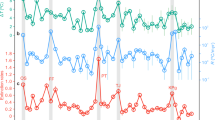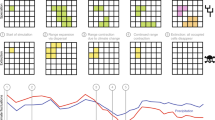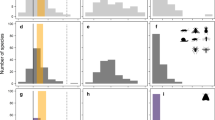Abstract
Assessing extinction risk from climate drivers is a major goal of conservation science. Few studies, however, include a long-term perspective of climate change. Without explicit integration, such long-term temperature trends and their interactions with short-term climate change may be so dominant that they blur or even reverse the apparent direct relationship between climate change and extinction. Here we evaluate how observed genus-level extinctions of arthropods, bivalves, cnidarians, echinoderms, foraminifera, gastropods, mammals and reptiles in the geological past can be predicted from the interaction of long-term temperature trends with short-term climate change. We compare synergistic palaeoclimate interaction (a short-term change on top of a long-term trend in the same direction) to antagonistic palaeoclimate interaction such as long-term cooling followed by short-term warming. Synergistic palaeoclimate interaction increases extinction risk by up to 40%. The memory of palaeoclimate interaction including the climate history experienced by ancestral lineages can be up to 60 Myr long. The effect size of palaeoclimate interaction is similar to other key factors such as geographic range, abundance or clade membership. Insights arising from this previously unknown driver of extinction risk might attenuate recent predictions of climate-change-induced biodiversity loss.
This is a preview of subscription content, access via your institution
Access options
Access Nature and 54 other Nature Portfolio journals
Get Nature+, our best-value online-access subscription
$29.99 / 30 days
cancel any time
Subscribe to this journal
Receive 12 digital issues and online access to articles
$119.00 per year
only $9.92 per issue
Buy this article
- Purchase on Springer Link
- Instant access to full article PDF
Prices may be subject to local taxes which are calculated during checkout





Similar content being viewed by others
Data availability
All data used to conduct analyses are available at https://github.com/Ischi94/pal-int-extinction.
Code availability
All scripts used to conduct analyses are available at https://github.com/Ischi94/pal-int-extinction.
References
Molinos, J. G. et al. Climate velocity and the future global redistribution of marine biodiversity. Nat. Clim. Change 6, 83–87 (2016).
Pecl, G. T. et al. Biodiversity redistribution under climate change: impacts on ecosystems and human well-being. Science 355, eaai9214 (2017).
Brook, B. W. & Alroy, J. Pattern, Process, Inference and Prediction in Extinction Biology (Royal Society, 2017).
Barnosky, A. D. et al. Has the Earth’s sixth mass extinction already arrived? Nature 471, 51–57 (2011).
Thomas, C. D. et al. Extinction risk from climate change. Nature 427, 145–148 (2004).
Urban, M. C. Accelerating extinction risk from climate change. Science 348, 571–573 (2015).
Collins, K. S., Edie, S. M., Hunt, G., Roy, K. & Jablonski, D. Extinction risk in extant marine species integrating palaeontological and biodistributional data. Proc. Biol. Sci. 285, 20181698 (2018).
Finnegan, S. et al. Paleontological baselines for evaluating extinction risk in the modern oceans. Science 348, 567–570 (2015).
van Woesik, R. et al. Hosts of the Plio-Pleistocene past reflect modern-day coral vulnerability. Proc. R. Soc. B 279, 2448–2456 (2012).
Harnik, P. G. et al. Extinctions in ancient and modern seas. Trends Ecol. Evol. 27, 608–617 (2012).
Kiessling, W. & Kocsis, Á. T. Adding fossil occupancy trajectories to the assessment of modern extinction risk. Biol. Lett. 12, 20150813 (2016).
Calosi, P., Putnam, H. M., Twitchett, R. J. & Vermandele, F. Marine metazoan modern mass extinction: improving predictions by integrating fossil, modern, and physiological data. Annu. Rev. Mar. Sci. 11, 369–390 (2019).
Wiens, J. J. & Graham, C. H. Niche conservatism: integrating evolution, ecology, and conservation biology. Annu. Rev. Ecol. Evol. Syst. 36, 519–539 (2005).
Beaugrand, G. Theoretical basis for predicting climate-induced abrupt shifts in the oceans. Philos. Trans. R. Soc. B 370, 20130264 (2015).
Lord, J. P., Barry, J. P. & Graves, D. Impact of climate change on direct and indirect species interactions. Mar. Ecol. Prog. Ser. 571, 1–11 (2017).
Bond, D. P. G. & Grasby, S. E. On the causes of mass extinctions. Palaeogeogr. Palaeoclimatol. Palaeoecol. 478, 3–29 (2017).
Penn, J. L., Deutsch, C., Payne, J. L. & Sperling, E. A. Temperature-dependent hypoxia explains biogeography and severity of end-Permian marine mass extinction. Science 362, eaat1327 (2018).
Reddin, C. J., Nätscher, P. S., Kocsis, Á. T., Pörtner, H.-O. & Kiessling, W. Marine clade sensitivities to climate change conform across timescales. Nat. Clim. Change 10, 249–253 (2020).
Bolker, B. M. et al. Generalized linear mixed models: a practical guide for ecology and evolution. Trends Ecol. Evol. 24, 127–135 (2009).
Burnham, K. P. & Anderson, D. R. Model Selection and Multimodel Inference. A Practical Information-Theoretic Approach 2nd edn (Springer, 2010).
McKinney, M. L. Extinction vulnerability and selectivity: combining ecological and paleontological views. Annu. Rev. Ecol. Syst. 28, 495–516 (1997).
Foote, M., Crampton, J. S., Beu, A. G. & Cooper, R. A. On the bidirectional relationship between geographic range and taxonomic duration. Paleobiology 34, 421–433 (2008).
Payne, J. L., Truebe, S., Nützel, A. & Chang, E. T. Local and global abundance associated with extinction risk in late Paleozoic and early Mesozoic gastropods. Paleobiology 37, 616–632 (2011).
Harnik, P. G. Direct and indirect effects of biological factors on extinction risk in fossil bivalves. Proc. Natl Acad. Sci. USA 108, 13594–13599 (2011).
Harnik, P. G., Simpson, C. & Payne, J. L. Long-term differences in extinction risk among the seven forms of rarity. Proc. R. Soc. B 279, 4969–4976 (2012).
Hopkins, M. J., Simpson, C. & Kiessling, W. Differential niche dynamics among major marine invertebrate clades. Ecol. Lett. 17, 314–323 (2014).
Svenning, J. ‐C. & Skov, F. Limited filling of the potential range in European tree species. Ecol. Lett. 7, 565–573 (2004).
Normand, S. et al. Postglacial migration supplements climate in determining plant species ranges in Europe. Proc. R. Soc. B 278, 3644–3653 (2011).
Stigall, A. L. When and how do species achieve niche stability over long time scales? Ecography 37, 1123–1132 (2014).
Steinbauer, M. J. et al. Biogeographic ranges do not support niche theory in radiating Canary Island plant clades. Glob. Ecol. Biogeogr. 25, 792–804 (2016).
Foster, G. L., Hull, P., Lunt, D. J. & Zachos, J. C. Placing our Current ‘Hyperthermal’ in the Context of Rapid Climate Change in our Geological Past (The Royal Society Publishing, 2018).
Leckie, R. M., Bralower, T. J. & Cashman, R. Oceanic anoxic events and plankton evolution: biotic response to tectonic forcing during the mid‐Cretaceous. Paleoceanography 17, 13-1–13-29 (2002).
Coxall, H. K. & Pearson, P. N. in Deep Time Perspectives on Climate Change: Marrying the Signal From Computer Models and Biological Proxies Vol. 2 (eds Williams, M. et al.) 351–387 (Geological Society of London, 2007).
Ritterbush, K. A. & Foote, M. Association between geographic range and initial survival of Mesozoic marine animal genera: circumventing the confounding effects of temporal and taxonomic heterogeneity. Paleobiology 43, 209–223 (2017).
Stigall, A. L. Analysing links between biogeography, niche stability and speciation: the impact of complex feedbacks on macroevolutionary patterns. Palaeontology 56, 1225–1238 (2013).
BouDagher-Fadel, M. K. Evolution and Geological Significance of Larger Benthic Foraminifera (UCL Press, 2018).
Reddin, C. J., Kocsis, Á. T. & Kiessling, W. Marine invertebrate migrations trace climate change over 450 million years. Glob. Ecol. Biogeogr. 27, 704–713 (2018).
Valentine, J. W. Temporal bias in extinctions among taxonomic categories. J. Paleontol. 48, 549–552 (1974).
Kocsis, Á. T., Reddin, C. J., Alroy, J. & Kiessling, W. The r package divDyn for quantifying diversity dynamics using fossil sampling data. Methods Ecol. Evol. 10, 735–743 (2019).
Gradstein, F. M., Ogg, J. G., Schmitz, M. & Ogg, G. The Geologic Time Scale 2012 (Elsevier, 2012).
Foote, M. Origination and extinction components of taxonomic diversity: general problems. Paleobiology 26, 74–102 (2000).
Veizer, J. & Prokoph, A. Temperatures and oxygen isotopic composition of Phanerozoic oceans. Earth Sci. Rev. 146, 92–104 (2015).
Song, H., Wignall, P. B., Song, H., Dai, X. & Chu, D. Seawater temperature and dissolved oxygen over the past 500 million years. J. Earth Sci. 30, 236–243 (2019).
Grossman, E. L. Applying oxygen isotope paleothermometry in deep time. Paleontol. Soc. Pap. 18, 39–68 (2012).
Henkes, G. A. et al. Temperature evolution and the oxygen isotope composition of Phanerozoic oceans from carbonate clumped isotope thermometry. Earth Planet. Sci. Lett. 490, 40–50 (2018).
Ryb, U. & Eiler, J. M. Oxygen isotope composition of the Phanerozoic ocean and a possible solution to the dolomite problem. Proc. Natl Acad. Sci. USA 115, 6602–6607 (2018).
R Core Team. R: A Language and Environment for Statistical Computing (R Foundation for Statistical Computing, 2019).
Bates, D., Mächler, M., Bolker, B. & Walker, S. Fitting linear mixed-effects models using lme4. J. Stat. Soft. https://doi.org/10.18637/jss.v067.i01 (2015).
Wickham, H. ggplot2: Elegant Graphics for Data Analysis (Springer, 2016).
Quené, H. & van den Bergh, H. Examples of mixed-effects modeling with crossed random effects and with binomial data. J. Mem. Lang. 59, 413–425 (2008).
Malik, W. A., Marco-Llorca, C., Berendzen, K. & Piepho, H.-P. Choice of link and variance function for generalized linear mixed models: a case study with binomial response in proteomics. Commun. Stat. Theory Methods 49, 1–20 (2019).
Zuur, A., Ieno, E. N., Walker, N., Saveliev, A. A. & Smith, G. M. Mixed Effects Models and Extensions in Ecology with R (Springer Science & Business Media, 2009).
Fox, G. A., Negrete-Yankelevich, S. & Sosa, V. J. Ecological Statistics: Contemporary Theory and Application (Oxford Univ. Press, 2015).
Lieberman, M. D. & Cunningham, W. A. Type I and Type II error concerns in fMRI research: re-balancing the scale. Soc. Cogn. Affect. Neurosci. 4, 423–428 (2009).
Durbin, J. & Watson, G. S. Testing for serial correlation in least squares regression. Biometrika 58, 1–19 (1971).
Nakagawa, S., Johnson, P. C. D. & Schielzeth, H. The coefficient of determination R2 and intra-class correlation coefficient from generalized linear mixed-effects models revisited and expanded. J. R. Soc. Interface 14, 20170213 (2017).
IPCC. Special Report on Global Warming of 1.5 °C (eds Masson-Delmotte, V. et al.) (WMO, 2018).
Acknowledgements
This work was supported by the Deutsche Forschungsgemeinschaft (KI 806/16–1 and STE 2360/2-1) and is embedded in the Research Unit TERSANE (FOR 2332: Temperature-related stressors as a unifying principle in ancient extinctions). M.J.S. acknowledges support by European Research Council grant no. 741413 Humans on Planet Earth (HOPE).
Author information
Authors and Affiliations
Contributions
M.J.S. was responsible for conceptualization and supervision. G.H.M. undertook formal analysis, investigation and visualization. J.v.D. designed the methodology. W.K. secured resources. W.K. and M.J.S. were responsible for funding acquisition. G.H.M. wrote the original draft and the other authors were involved in reviewing and editing the final manuscript.
Corresponding author
Ethics declarations
Competing interests
The authors declare no competing interests.
Additional information
Peer review information Nature Ecology & Evolution thanks Michael Benton, Noel Heim and the other, anonymous, reviewer(s) for their contribution to the peer review of this work. Peer reviewer reports are available.
Publisher’s note Springer Nature remains neutral with regard to jurisdictional claims in published maps and institutional affiliations.
Extended data
Extended Data Fig. 1 Density distribution of GLMM results.
The difference in distributions were used to assess change in extinction probability of taxa due to paleoclimate interaction. Upper row blue areas show distributions of extinction risk subsequent to cooling–cooling interaction. Upper row red area cooling–warming interaction. Lower row blue area warming-cooling interaction. Lower row red area warming–warming interaction.
Extended Data Fig. 2 Temporal memory of the effect of paleoclimate interaction compared to the intensity of the effect.
The model with the lowest ∆AIC (here representatively shown for cooling–cooling of bivalvia) universally showed the highest effect of past temperature change on extinction risk. Effect intensity decreased with increasing AIC of the remaining models, enabling determination of the temporal memory of the effect. Trends one to ten covered a successively growing time of temperature history: Trend1 ranged one stage back, trend2 two stages, …, trend10 ten stages (methods).
Extended Data Fig. 3 Temporal memory of paleoclimate interaction for fossil clades related to genus duration.
a, Temporal memory versus median durations of fossil clades and (b) mean durations. Grey area depicts the 95 % confidence interval of the regression slope. Trend line and R2 value are based on univariate linear regression and are not significant (p-value for median duration = 0.79 and for mean duration = 0.63).
Extended Data Fig. 4 Results of simulations for null model.
Change of extinction risk of null models based on simulated data for datasets with varying sizes for warming–warming palaeoclimate interaction is shown in (a), and for cooling–cooling interaction in (b). We simulated datasets with increasing number of observations and calculated 100 GLMM’s for each to determine Type I Error rate of models used in our analysis. The shaded area shows the distribution of all 100 model results for warming–warming and cooling–cooling interaction respectively. The mean for each number of observations and its corresponding 95 % Wald Confidence Interval is shown in (c), where the red points and shaded intervals show the simulated response to warming–warming palaeclimate interaction, and blue points and shaded intervals to cooling–cooling.
Extended Data Fig. 5 Number of fossil genera within datasets.
The number of genera is shown for each fossil clade and for each stage. This is based on raw data (before filtering and processing of data).
Extended Data Fig. 6 Model comparison of subsampled data for robustness testing for bivalves and reptiles.
Values show AIC values after shareholder quorum subsampling (SQS) and classical rarefaction (CR). After subsampling, model quality of traditional models (change only) is compared to quality of models taking palaeoclimate interaction into account (change & trend), to test if models improve when long-term temperature trends are included. Red text indicates an improved model performance when palaeoclimate interactions are included. We used a shareholder quorum of 0.4 and classical rarefaction with 50 occurrences.
Extended Data Fig. 7 Simulations for potential autocorrelation bias.
a, Simulations were used to test if autocorrelation between the extinction signal and climate proxy data could bias our results. The results from these simulations show that the simulated extinction risk for both blue (inversely correlated) and red noise (positively correlated) is within the range of the null models, indicating that autocorrelation does not bias our results. b, We additionally tested for serial autocorrelation of the final GLMMs. No model shows indication for a strong serial autocorrelation. Durbin–Watson statistic values below 1 generally indicate a strong positive autocorrelation, values above 3 a strong negative autocorrelation and values around 2 no autocorrelation.
Extended Data Fig. 8 The effect of mass extinctions on the observed effect.
Models fitted on all fossil groups and all stages were compared to models excluding stages where the big five mass extinctions occurred (End-Ordovician, Late Devonian, End-Permian, End-Triassic and End-Cretaceous). For each model, the proportion of the variance using the conditional coefficient for determination (pseudo-R2) was quantified.
Supplementary information
Supplementary Information
Supplementary Figs, 1–4, Tables 1–8 and notes.
Rights and permissions
About this article
Cite this article
Mathes, G.H., van Dijk, J., Kiessling, W. et al. Extinction risk controlled by interaction of long-term and short-term climate change. Nat Ecol Evol 5, 304–310 (2021). https://doi.org/10.1038/s41559-020-01377-w
Received:
Accepted:
Published:
Issue Date:
DOI: https://doi.org/10.1038/s41559-020-01377-w



